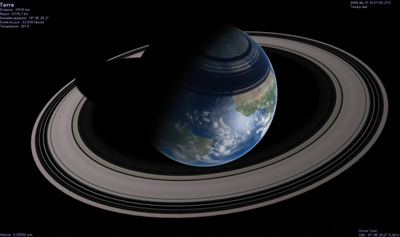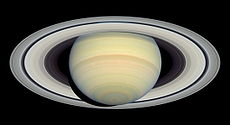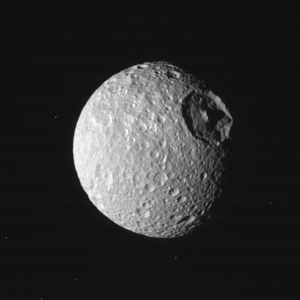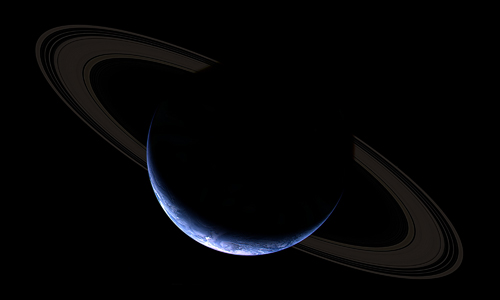By now, you’ve probably seen this very interesting video. It imagines what it would look like if Earth had rings like those of Saturn!
This is a very cool idea, and it went viral pretty quickly when it came out a few weeks ago. And of course I’m for anything that increases people’s interest in astronomy.
But the nitpicker in me can’t resist thinking the idea through a little more. The video is accurate as far as it goes, discussing the geometry of the rings and the viewing angles. But it makes some assumptions that, in real life (if you can say such a thing), are worth investigating further. Note: some of this is speculation on my part, based on my knowledge of astronomy and some reading I’ve done on rings. I wouldn’t take this as gospel (I wouldn’t take anything as gospel); instead think of it as idle brain stimulation.
With this ring, I thee shred
 |
| Earth with rings image courtesy Damien Bouic. |
Rings of rock and ice
OK, so Earth could have rings. But would they last? That’s an interesting question. Saturn’s rings are made of ice, but Saturn is 1.4 billion kilometers (850 million miles) from the Sun, where things are cold. At the Earth’s distance from the Sun, small ice particles would quickly be destroyed by sunlight (regular old sunlight would help sublimate the ice from a solid to a gas, and UV light would break apart water molecules). So if the Earthrings were made of ice like Saturn’s they’d disappear pretty quickly, certainly on a timescale far shorter than the age of the Earth.
If the Earthrings were made of rock they might last a longer time. Pressure from sunlight might be an important thing to think about for the smallest particles (though they would also be replenished as bigger particles grind together)… as well as perturbations from the Sun’s and Moon’s gravity. To be honest that’s a bit above my pay grade to do that calculation (and it looks like long-term stability would really be an issue), but let’s assume that small pebbles and such could last long enough to give Earth a ring system. Would Earthrings look like they did in that video?
Does this ring make me look fat?
 Well, yes and no. They would still be bright enough to see at night. Ice is shiny, which is one reason Saturn’s rings are so bright. Rock is much duller, so the Earthrings wouldn’t be quite so shiny. But the Moon is made of rock that is very dark, yet is incredibly bright in the night sky. It’s safe to assume the rings would be obvious at night then, too.
Well, yes and no. They would still be bright enough to see at night. Ice is shiny, which is one reason Saturn’s rings are so bright. Rock is much duller, so the Earthrings wouldn’t be quite so shiny. But the Moon is made of rock that is very dark, yet is incredibly bright in the night sky. It’s safe to assume the rings would be obvious at night then, too.
One interesting bit: the rings would look different if you were seeing sunlight reflected off them versus seeing the Sun through them. Sunlight seen through them would be reddened if the rings were dusty, just like a sunset looks very red if there is haze and junk in the air. Saturn’s rings look very different when Cassini has taken images showing them from the unlit side. So in the summer the rings might look one way when you see sunlight reflected off them, and different in the winter when they are seen from the unlit side.
Would they be visible during the day? I think so, since the Moon is easily visible during the day. Being close and broad, they should be bright enough to spot above the brightness of the sky itself.
God of the gaps
What about the structure? In the video they simply took Saturn’s rings and transposed them on the Earth. But that’s not really accurate, because of the gaps.
 |
| If Mimas really were a Death Star, clearing a gap in the rings would be a lot easier. |
So the actual Earthrings would look substantially different than in the video. There may not be any major gaps in the rings, or there might be numerous smaller ones (which wouldn’t be hard to see from the ground). The color would be different, too.

Saturn’s rings, annotated with names and distance from the center of the planet. Click to embiggen beyond your wildest dreams.
One ring to rue them all
How would this affect life on Earth? They would be more than just pretty features! The shadow they cast would change the amount of sunlight reaching the ground; in the northern hemisphere summer the Earthring shadow would be cast on the southern hemisphere (where it would be winter), and vice-versa. That means winters in both hemispheres might be somewhat colder. Plants would have to adapt to the lessened amount of light. The actual diminution of light would depend on how wide and how thick the rings are, too.
Ground-based optical astronomy would be screwed pretty well. It’s hard enough to observe when the Moon is out; imagine a sky filled with rings! It would actually be difficult to see stars at all if you lived at latitudes where the rings ate up a goodly-sized piece of the sky. I wonder how legends and myths would be changed on such an Earth?
And the Earthrings would certainly affect space travel! They would be a major hazard to spaceflight; you really wouldn’t want to plow through them at several kilometers per second unless breathing vacuum is something you enjoy. Also, the rings would be located in the very worst possible place: right over the Earth’s equator. That’s the best place to put satellites – they’re easier to launch near the equator (you get a boost of 1600 kph from the Earth’s spin that way) and that’s where you want to put geosynchronous satellites for weather and communications. A lot of astronomical (and no doubt spy) satellites are in polar orbits, but again you wouldn’t want them plunging through the rings twice each orbit. Space debris is a bad enough problem now with all the junk in orbit; having billions of particles out there wouldn’t help any!
So the Earthrings would be incredible, and lovely, and ethereal, but they would come at a terrible cost: astronomy and space travel. I’m sure we’d figure out some way to launch rockets anyway – giant absorbing puffy shields around rockets, maybe – but that would come with its own cost of high mass, which makes getting to orbit that much harder.
Ringing off
So all in all, it’s fun to think about, and remarkable to simulate and actually see in an animation – what a sight they would be! – but all in all, I think I like the Earth the way it is.
 |
| Image courtesy Damien Bouic. |